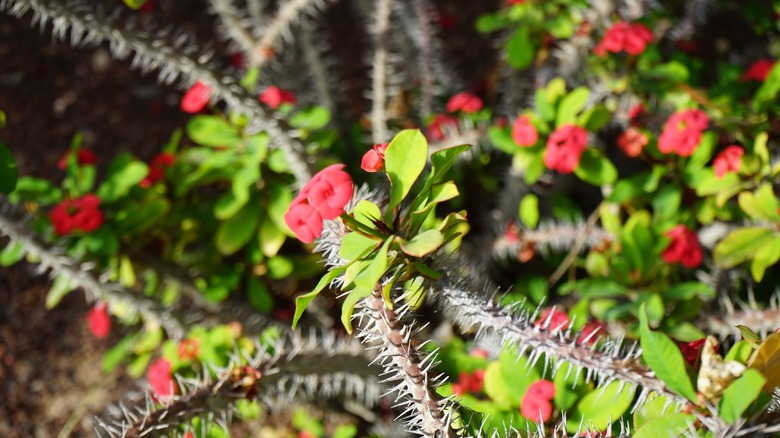The Holy Sounding Succulent That Can Handle The Toughest Growing Conditions
Succulents are extremely popular on social media, perfect for those new to that #plantparent life as they are low-maintenance and very forgiving. These lovely, hearty plants come in over 12,000 varieties with multiple colorful succulents that thrive indoors to create a rainbow on your shelves. Whether you want a tiny succulent for your desk or prefer a tall, blooming succulent flanking your doorstep, you can find a plant that meets your needs. While you might be familiar with indoor-favorite succulents such as aloe and jade plants, there are multiple succulents you can grow outside as well. One of the best succulents to grow as an ornamental plant you might not be aware of is the crown of thorns (Euphorbia milii), a very drought-tolerant succulent that can thrive in the toughest growing conditions.
Originating from Madagascar, the holy-sounding succulent's name comes from its history in the Middle East. The University of Wisconsin-Madison states that it was brought to the region prior to the approximate historical birth of Jesus, which lends itself to being associated with Biblical stories. Other names for the crown of thorns include Christ plant and Christ thorn. This beautiful cactus-like plant is a close relative to poinsettia. It features oval-shaped leaves with multiple thorns surrounded by flowers grown in clusters. As a houseplant, this spiny plant often grows up to 2 feet–and 3 feet when outside–bursting with vibrant red or yellow flowers. If you've never grown succulents, here's everything you should know before planting or taking care of a crown of thorns.
How to care for your crown of thorns succulent
Crown of thorns can survive in intense sun, faring well even in temperatures above 90 degrees. Outside, the plant thrives in rock gardens, containers, and as a border planting for a garden or sidewalk. For the best growth and flowers, provide direct sunlight, preferably 6 to 8 hours per day, and rotate the plant slightly throughout the week for even light exposure.
Crown of thorns blooms throughout the year, providing lovely red or yellow flowers in the spring or year-round in tropical areas, which is why it's common among Florida gardens. It can tolerate most well-drained soils, preferring to dry a bit between watering sessions. Don't be concerned if your plant loses some leaves, which naturally drop upon maturation. Yellow crispy leaves can indicate underwatering, while overwatering symptoms include yellow leaves and a rotten stem. There's not any concern for serious diseases for the crown of thorns, though watch for signs of mealybugs, spider mites, and thrips. Fertilization needs are minor, only requiring liquid organic fertilizer every few weeks during the growing season.
If you're looking for the best deer-resistant flowering plants, the crown of thorns is on the list. Best of all, it's not an invasive species, so you don't have to worry about having it overtaking your yard. Do take care to wear gloves and protective eyewear if you trim cuttings to propagate this succulent. It's best to let the sap dry before you handle crown of thorns cuttings. Like other Euphorbia species, the crown of thorns contains a white sap that can irritate the skin and eyes upon contact, even causing temporary blindness in some cases. If the sap gets into your eyes, seek medical attention right away. While a crown of thorns can be a beautiful houseplant, keep it out of reach of children and animals.

